Catalan Way
The Catalan Way (Catalan: Via Catalana), also known as the Catalan Way towards Independence (Catalan: Via Catalana cap a la Independència), was a 400-kilometre (250 mi) human chain in support of Catalan independence from Spain. It was organized by the Assemblea Nacional Catalana (ANC) and supported by 14 nongovernmental groups.[1] It took place in Catalonia on 11 September 2013, which is the National Day of Catalonia, known as Diada.[1][2] Catalonia's Department of the Interior estimated the number of participants at about 1.6 million.[3] The human chain followed the ancient Via Augusta, from Le Perthus (France, Vallespir) up to Alcanar (Spain, Montsià). According to Carme Forcadell, president of the ANC at that time, it was "a symbol of the unity of Catalan people to achieve national sovereignty".[4]
| Catalan Way | |
|---|---|
Catalan Way (section 235) in Via Augusta street, Tarragona | |
| Date | 11 September 2013 |
| Location | Catalonia |
| Goals | Independence of Catalonia |
| Methods | Protest march, street protest |
Plans for the Catalan Way were presented for the first time on 19 June 2013, at the Museu d'Història de Catalunya; the inspiration for these was the 1989 Baltic Way. The presentation included Henn Karits and Ülo Laanoja, two members of the organization which staged the Baltic Way.[5] Three weeks before the event, more than 350,000 people had registered to participate.[6][7] In total, the organizers mobilized about 1,500 buses and 30,000 volunteers to help organize the event.[1][8]
Catalan Way 2014 took place the next year.
Historical precedents
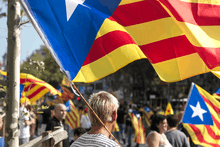
On 23 August 1989, the Baltic Way was organized by the people of Estonia, Latvia and Lithuania.[1] This human chain linked the capitals of the three countries in favour of their independence from the Soviet Union.[1] The three republics became independent in August 1991, after the Moscow coup d'état attempt on 21 August 1991. According to the Baltic Way's manifesto, "A common European home can only [be] set up if all European nations are granted a free right to self-determination".[9]
The 2010 Catalan autonomy protest was a demonstration held in central Barcelona on 10 July 2010 against the limits set to the autonomy of Catalonia within Spain, and particularly against a then recent decision of the Spanish Constitutional Court to annul or reinterpret several articles of the 2006 Statute of Autonomy of Catalonia, approved in referendum by 73.9% of the voters.[10] The number of people taking part in the demonstration was estimated at between 1.1 million (according to the local police) and 1.5 million (according to the organisers)[11][12] Madrid-based newspaper El País estimated the number of demonstrators at 425,000.[13]
Catalonia saw several local referenda for independence take place in hundreds of villages between 13 September 2009 and April 2011, with an overwhelming number of "yes" votes being cast.
The 2012 Catalan independence demonstration, organized by the Catalan National Assembly, argued that Catalonia should become an independent state within the European Union, under the slogan "Catalonia, new state in Europe".[6] The number of participants was estimated at about 1.5 million according to Barcelona's Municipal Police and Catalonia's Department of the Interior,[14] about 2 million according to the organizers, and about 600,000 according to the delegation of the Spanish government in Catalonia.[15][16][17]
Pre-Catalan Way activities
Registration and previous acts
The Catalan Way was presented for the first time on 19 June 2013, at the Museu d'Història de Catalunya. The presentation included Henn Karits and Ülo Laanoja, two members of the organization which staged the Baltic Way.[5]
On 4 July, the National Catalan Assembly (ANC) opened the registering period through its website. More than 22,000 people were registered during the first 24 hours and over 78,000 the first week.[18] Registrations grew steadily since then and, three weeks before the event, more than 350,000 people had already signed in.[19][20][6][7] The southern areas of Catalonia were considered the hardest ones to fill due to being less populated and farther from Barcelona.[21] On 2 September, nine days before the Diada, no section of the Catalan Way was left with low occupancy.[22]
During the summer, some practice runs of the Catalan Way took place in several cities around Catalonia.[1][23]
Response of the political parties
Convergència Democràtica de Catalunya (CDC), Esquerra Republicana de Catalunya (ERC) and Candidatura d'Unitat Popular (CUP) expressed their support and participation in the Catalan Way, while Partit dels Socialistes de Catalunya (PSC), Partit Popular (PP) and Ciutadans opposed.[24] Initiative for Catalonia Greens (ICV) asked their activists to join the human chain organized by Procés Constituent to surround La Caixa the same day.[25]
| Political Party | 2012 | 2013 |
|---|---|---|
| CiU/Convergència Democràtica de Catalunya (CDC) | Yes | Yes |
| CiU/Unió Democràtica de Catalunya (UDC) | Yes | No |
| Esquerra Republicana de Catalunya (ERC) | Yes | Yes |
| Partit dels Socialistes de Catalunya (PSC) | No | No |
| Partit Popular de Catalunya (PP) | No | No |
| Initiative for Catalonia Greens (ICV-EUiA) | Yes | No |
| Ciutadans - Partit de la Ciutadania (C's) | No | No |
| Candidatura d'Unitat Popular (CUP) | No[lower-alpha 1] | Yes |
Artur Mas, President of the Generalitat of Catalonia and Núria de Gispert, President of the Parliament of Catalonia, decided not to participate for "institutional reasons", although they encouraged the people to participate in the Catalan Way and announced that they would meet with the organizers of the human chain on the same 11 September.[1][6]
Chain's path
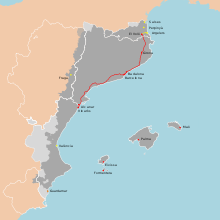
In Catalonia
The human chain followed the old Via Augusta, crossing the following 86 towns and municipalities (sorted from North to South):[1] Le Perthus, la Jonquera, Pont de Molins, Figueres, Santa Llogaia d'Àlguema, Bàscara, Orriols, Sarrià de Ter, Sant Julià de Ramis, Girona, Fornells de la Selva, Riudellots de la Selva, Tordera, Pineda de Mar, Calella, Sant Pol de Mar, Canet de Mar, Arenys de Mar, Caldes d'Estrac, Sant Vicenç de Montalt, Sant Andreu de Llavaneres, Mataró, Vilassar de Mar, Premià de Mar, El Masnou, Montgat, Badalona, Sant Adrià de Besòs, Barcelona, l'Hospitalet de Llobregat, Esplugues de Llobregat, Sant Just Desvern, Sant Feliu de Llobregat, Molins de Rei, Sant Vicenç dels Horts, Cervelló, Vallirana, Ordal, Cantallops, Sant Cugat Sesgarrigues, Olèrdola, Vilafranca del Penedès, Santa Margarida i els Monjos, la Ràpita, l'Arboç, Castellet i la Gornal, Bellvei, el Vendrell, Roda de Berà, Creixell, Clarà, Torredembarra, Altafulla, Tarragona, Reus, Riudoms, Montbrió del Camp, Mont-roig del Camp, l'Hospitalet de l'Infant, l'Ametlla de Mar, El Perelló, l'Ampolla, Camarles, l'Aldea, Amposta, Sant Carles de la Ràpita and Alcanar.[26]
In Barcelona, the path ran along several main streets, such as avinguda Diagonal, plaça de Sant Jaume and Eixample.[27]
Branches out of Catalonia
Two extensions of the Catalan Way, one up to Le Boulou, France, and the other one down to Vinaròs, Valencian Community, were made. The Northern Catalonia ANC territorial assembly was responsible to extend the Catalan Way from Pertús to el Voló, and several civic and political Valencian organizations, coordinated by Acció Cultural del País Valencià, prepared an extension from Vinaròs.[28]
International Catalan Way
The Foreign Assemblies of the ANC, in collaboration with the Catalan Communities Abroad and Catalans al Món, organized more than 116 Catalan Ways carried out mainly between 1 August and 11 September 2013 in major cities around the world "to support the democratic independence process of Catalonia". More than 8,000 Catalans and supporters of Catalonia's independence participated in the International Catalan Way.[29]
- Americas: Toronto, Vancouver and Montreal (Canada), Atlanta, Boston, Boulder, Chicago, Cincinnati, Dallas, Houston, Independence, Los Angeles, Miami, Minneapolis, New York City, Raleigh, San Francisco, Seattle and Washington, D.C. (United States), Guadalajara, Mexico City, Puebla and Tulum (Mexico), Managua (Nicaragua), Panama City (Panama), San José (Costa Rica), Asunción (Paraguay), Bogotá and Medellín (Colombia), Buenos Aires, Castelar, Córdoba, Paranà and Rosario (Argentina), Curitiba, Rio de Janeiro and São Paulo (Brazil), Lima (Peru), Montevideo (Uruguay), Quito (Ecuador) and Santiago (Chile).
- Europe: Andorra la Vella (Andorra), Athens (Greece), Bergen, Oslo and Trondheim (Norway), Berlin, Cologne, Frankfurt, Hamburg, Mannheim and Munich (Germany), Brussels (Belgium), Budapest (Hungary), Copenhagen (Denmark), Cork and Dublin (Ireland), Den Haag (Netherlands), Dubrovnik and Zadar (Croatia), Geneva, Lausanne and Zurich (Switzerland), Gothenburg and Stockholm (Sweden), Helsinki (Finland), Lisbon (Portugal), Ljubljana (Slovenia), Edinburgh, London and Manchester (United Kingdom), Luxembourg (Luxembourg), Paris, Paris-Eurodisney, Lyon and Toulouse (France), Prague (Czech Republic), Reykjavík (Iceland), Alghero, Rome and Venice (Italy), Sarajevo (Bosnia and Herzegovina), Szczecin (Poland) and Vienna (Austria).
- Africa: Johannesburg (South Africa), Mbour (Senegal) and Serekunda (Gambia).
- Asia: Doha (Qatar), Dubai (United Arab Emirates), Jerusalem (Israel), Bangkok (Thailand), Hong Kong, Beijing, Guangzhou, Shanghai and Shenyang (China), Everest and Pokhara (Nepal), Seoul (South Korea) and Tokyo (Japan).
- Oceania: Auckland and Wellington (New Zealand), Brisbane, Melbourne, Perth and Sydney (Australia)
- Previous Catalan Way in Lisbon, on 30 August
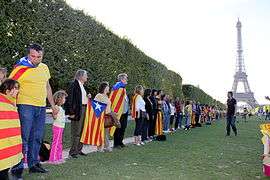 Previous Catalan Way in Paris, on 2 September
Previous Catalan Way in Paris, on 2 September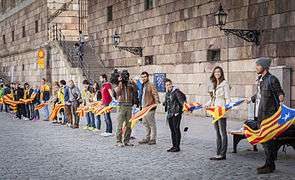 Previous Catalan Way in Stockholm, on 31 August
Previous Catalan Way in Stockholm, on 31 August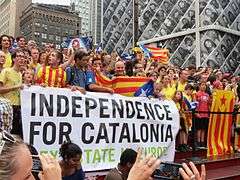 Pro-independence protest in Times Square, New York City, on 31 August
Pro-independence protest in Times Square, New York City, on 31 August
Consequences
Reactions against
Initially, 12-O Moviment Cívic called for a demonstration in the Sagrada Família square to circle around this monument, show their support for the "unity of Spain" and "break the pro-independence chain".[30] However, the Ministry of the Interior of the Government of Catalonia ruled that this demonstration could not be at the same time and in the same location for security reasons.[31] This, together with the limited support of the anti-independence political parties, led the organizers to call off the event and invited unionist Catholics to go to the Temple to pray and postponed an answer to the Catalan Way on 12 October, the Fiesta Nacional de España.[32]
Fifteen far-right people holding pre-constitutional, Falange, National Alliance flags assaulted the official ceremony of the Catalan National Day in the Catalan Government Centre in Madrid.[33] They attacked those present, including the MP Josep Sánchez i Llibre, caused damage to furniture and threw pepper spray, shouting "No nos engañan, Cataluña es España" ("They don't deceive us, Catalonia is Spain").[34] Medical services treated a person with mental breakdown, another for bruising, and a third for eye irritation. Among the wounded there were elderly people and a five-year-old girl.[35]
Political consequences
The Catalan National Assembly claimed that the day after the Catalan Way the Catalan government should set the date and the question of self-determination referendum in Catalonia, that "should be able to answer with a yes or no".[36] The Minister of the Presidency and spokesman of the Government of Catalonia Francesc Homs said the day after the Catalan way that "before the end of the year there should be a date and a question".[37]
The Deputy Prime Minister of Spain, Soraya Sáenz de Santamaría, said the day after that the executive had an obligation "to listen to all Spaniards", both "the people coming out" and the "silent majority" that "stay at home", who also "entitled" to ensure "for their freedoms and their views".[38] For its part, the Spain's Minister of Foreign Affairs José Manuel García-Margallo, admitted that the Catalan Way was a "success of call, organization, logistics and communication", although he said that Spain would never accept a referendum agreed with Catalonia.[39]
International reaction
European Commission spokesmen showed "great respect" for the Catalan Way and said they were "aware of its importance", although they recalled that the EU executive "can not interfere" in the internal affairs of member states.[40]
Latvia's PM Valdis Dombrovskis said it would recognize Catalonia as independent state, if declared in a legitimate process. Mr. Dombrovskis said: "If there is a clear will of the people and need for a referendum, we need to take that into account and seek means to make it real" [...] "Provided there is legitimacy of the process, I would say, theoretically, why not?". Latvia, however, considers the question an internal matter of Spain and PM's press secretary latter said that PM had tried to remain neutral instead of showing support to the Catalan cause.[41] Spanish government reacted asking to call the Latvian ambassador in Madrid to explain the prime minister's statements.[42]
On 14 September Lithuania's PM Algirdas Butkevičius said about Catalonia: "Each country must find its own path and has the right to self-determination. [...] I welcome all peaceful ways of expressing solidarity and self-determination". He also said he was "very pleased" that the Lithuanian example "inspire" the Catalan independence clamor.[43]
After the pressure of Spanish diplomacy,[44][45][46][47] Lithuania's Foreign Ministry posted a statement expressing "concern over the tendentious and erroneous interpretation" by the Spanish press over the Lithuanian position. The statement said, "The Soviet occupation of the Baltic nations cannot be compared with the situation in Spain. Spain is the democratic country, a member of the European Union, our close partner in the EU and NATO." It said all domestic matters in Spain "should be resolved according to democratic and legal measures that exist within the country, respecting the Constitution.".[48]
Following years
The Catalan Way was followed in the succeeding years by the Catalan Way 2014, the Free Way to the Catalan Republic (2015) and Go ahead, Catalan Republic (2016).
Gallery
.jpg) Catalan Way in Sant Carles de la Ràpita
Catalan Way in Sant Carles de la Ràpita Catalan Way in Amposta
Catalan Way in Amposta- Catalan Way in Tarragona
 Catalan Way at the Camp Nou
Catalan Way at the Camp Nou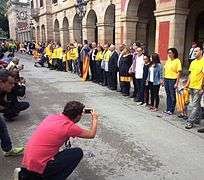 Catalan Way at the Parliament of Catalonia
Catalan Way at the Parliament of Catalonia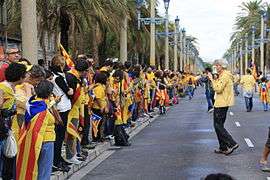 Catalan Way on Colom Avenue, Barcelona
Catalan Way on Colom Avenue, Barcelona Catalan Way in Badalona
Catalan Way in Badalona_-_Hores_pr%C3%A8vies_-_1.jpg) Catalan Way in Palafolls
Catalan Way in Palafolls- Catalan Way in Pontós
- Catalan Way in Pont de Molins
- Catalan Way in Figueres
See also
Notes
- Supported an alternative demonstration the same day.
References
- Moffett, Matt (5 September 2013). "Catalan Separatists to Link for Independence Cause". Wall Street Journal.
- Toyer, Julien. "Pragmatism may guide politicians as Catalonian separatism flares again". Reuters.
- "More than 1 million Catalans form human chain to promote their bid to break away from Spain". The Washington Post. Associated Press. 11 September 2013.
- "De la Jonquera a Alcanar: 400 km de 'Via Catalana' cap a l'estat independent" (in Catalan). Retrieved 1 July 2013.
- "Hand in Hand for Catalan independence over 250 miles and 86 towns". News Catalonia. 20 June 2013.
- Bosque, Daniel (8 September 2013). "Catalans rally for vast human chain independence bid". AFP.
- "Catalonia readies for large pro-independence march in Barcelona, human chain crossing region". The Washington Post. Associated Press. 10 September 2013.
- "Human chain for Catalan independence organized". World Bulletin. 6 September 2013.
- "Pro-independence supporters prepare a 400 km-long human chain on Catalonia's National Day". Catalan News Agency. 23 August 2013.
- "Catalan protesters rally for greater autonomy in Spain". BBC News. 10 July 2010. Retrieved 17 September 2012.
- "La manifestació ha desbordat totes les previsions". El Periódico de Catalunya. 10 July 2010. Archived from the original on 4 March 2012. Retrieved 25 August 2013.. (in Catalan)
- "Un millón de personas inundan Barcelona en una histórica manifestación de rechazo a la sentencia contra el Estatut". La Vanguardia. 10 July 2010.
- Cálculo de asistentes (in Spanish)
- "400 Kilometer Menschenkette für die Unabhängigkeit". Die Welt (in German). 11 September 2013.
- Piñol, Àngels (11 September 2012). "El independentismo catalán logra una histórica exhibición de fuerza" (in Spanish). Barcelona. El País. Retrieved 12 September 2012.
- "Diada.- El Govern central xifra l'assistència en 600.000 persones" (in Catalan). Barcelona. Europa Press. 11 September 2012. Archived from the original on 2 November 2012. Retrieved 13 September 2012.
- "La delegació del govern espanyol a Catalunya xifra en 600.000 els assistents a la manifestació de la Diada" (in Catalan). Madrid. Agència Catalana de Notícies. 11 September 2012. Archived from the original on 13 September 2014. Retrieved 13 September 2012.
- "Més de 78.000 inscrits a la Via Catalana en una setmana" (in Catalan). VilaWeb. Retrieved 11 July 2013.
- "Ja hi ha més de cent mil inscrits a la Via Catalana". VilaWeb. Retrieved 12 July 2013.
- "250.000 inscritos para la cadena humana independentista de la Diada" (in Spanish). Cadena SER. EFE. Retrieved 11 July 2013.
- "L'ANC avisa que tothom que participi en la Via Catalana serà comptat com a independentista" (in Catalan). El Periódico de Catalunya. Retrieved 19 August 2013.
- "Ja no queda cap tram de la Via Catalana amb baixa ocupació" (in Catalan). VilaWeb. Retrieved 2 September 2013.
- "Més de 22.000 inscrits en 24 hores per a la cadena humana de l'11-S" (in Catalan). Ara. Retrieved 5 July 2013.
- "The majority of Catalan parties propose an independence vote in 2014 the day after the human chain". Catalan News Agency. 12 September 2013.
- Fornell, Ramon (11 September 2013). "Anti-capitalist independence for Catalonia". Demotix.com. Archived from the original on 2 July 2015. Retrieved 13 September 2013.
- "El recorregut de la cadena humana de l'Onze de Setembre ja és públic" (in Catalan). vilaweb. Retrieved 1 July 2013.
- "La Via Catalana passarà pels punts més emblemàtics de Barcelona". Barcelona TV. 19 June 2013.
- "Catalan Way Wins in Valencian Court". Help Catalonia. 11 September 2013. Archived from the original on 2 January 2014. Retrieved 13 September 2013.
- "Catalans Around the World Claim Independence from Spain". Global Voices. 11 September 2013.
- "Movimiento Cívico 12-O replicará a la Vía Catalana con un acto en la Sagrada Familia". La Vanguardia (in Spanish). 19 August 2013.
- "Interior autoriza el acto del Movimiento 12-O de la Diada pero prohíbe que coincida con la cadena". La Vanguardia (in Spanish). 5 September 2013.
- "El 12-O desconvoca la concentració a la Sagrada Família, però crida a anar-hi "a resar"" (in Catalan). 324.cat. 10 September 2013.
- "Un grupo ultraderechista boicotea el acto de la Generalitat en Madrid por la Diada". El País. 11 September 2013.
- "Un grup d'extrema dreta irromp a la seu de la Generalitat a Madrid per boicotejar l'acte de la Diada". Ara (in Catalan). 12 September 2013.
- "Doce detenidos tras el ataque ultraderechista contra la sede de la Generalitat en Madrid". Europa Press/Eldiario.es. 12 September 2013.
- "La ANC quiere una fecha para la consulta el día después de la cadena humana". El Mundo (in Spanish). 23 August 2013.
- "Homs: "Abans de final d'any hi ha d'haver una data i una pregunta"". El Punt Avui (in Catalan). 12 September 2013.
- "Santamaría apela a escuchar también a las 'mayorías silenciosas' tras la Diada". El Mundo (in Spanish). 12 September 2013.
- "Margallo admet que la Via Catalana va ser un èxit de convocatòria". El Punt Avui (in Catalan). 12 September 2013.
- "La CE mostra "gran respecte" per la Via Catalana i "és conscient de la seva importància"". ACN. 11 September 2013.
- "Catalonians praise Latvian PM for his support". Baltic News Network. 13 September 2013.
- "Spain demands explanation from Latvia of Catalonia comment". Reuters. 13 September 2013.
- "El primer ministre lituà: "Cada país ha de trobar el seu propi camí i té dret a l'autodeterminació"". Catalan News Agency. 14 September 2013.
- La diplomàcia letona i la lituana rectifiquen per la pressió espanyola, VilaWeb
- La reacció de la diplomàcia espanyola "sorprèn" el primer ministre lituà, ACN
- Latvia and Lithuania say the press offered a "biased" version of their Prime Ministers’ statements on Catalonia, Catalan News Agency
- Spain demands explanation from Latvia of Catalonia comment, Reuters
- "Almunia Says Catalonia Would Need to Leave EU if it Secedes From Spain comment". Wall Street Journal. 16 September 2013.
Further reading
- Castro, Liz, ed. (2013). What's up with Catalonia?. Ashfield, Massachusetts, USA: Catalonia Press. ISBN 978-1-61150-032-5.CS1 maint: extra text: authors list (link)
External links
| Wikimedia Commons has media related to Catalan Way. |
- Catalan Way official web site (in Catalan, English, French, and Spanish)
- International Catalan Way (in English)
- Promotional video (in Catalan), English subtitles
- Video with the best images of the Catalan Way